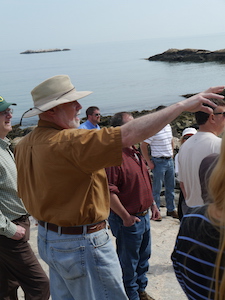COURSE DESCRIPTION
Ralph Lewis, State Geologist of Connecticut between 1997-2003, is presenting this two-part course that will provide a review of Connecticut’s bedrock tectonic history, glaciation deposition, and then a field excursion to Rocky Neck State Park to see examples of both the bedrock and surficial features discussed in the earlier lecture sessions. The lecture portion of the course will be held in Old Lyme, CT and then each participant will travel by separate car to Rocky Neck State Park in Niantic, a 15-minute trip from Old Lyme. The course will be limited to a maximum of 30 attendees to allow for an optimum walking tour of the geologic features at Rocky Neck State Park.
Part 1: The tectonic history of Connecticut’s Bedrock (1 hour):
This will be a one hour discussion of the 3 mountain building phases involved in the assembly of Connecticut’s crystalline bedrock (500 million -200 million years ago), followed by a discussion of Triassic/Jurassic rifting as the Atlantic Ocean began to open. The compression involved in the 3 assembly phases resulted in an overall N-S alignments of crystalline bedrock units. The Mesozoic extensional faulting that followed was influenced by the existing bedrock fabric. Today’s glacially-modified, bedrock-controlled topography, typified by N-S ridges and south draining streams, still reflects the events that compressed and stretched Connecticut’s four bedrock terranes. Issues relating to the complexities involved with groundwater flow in fractured crystalline bedrock will also be highlighted.
Part 2: History of glacial deposition in Connecticut (1 hour):
Following the birth of the Atlantic Ocean, two hundred million years of weathering and stream erosion exploited less resistant bedrock units and fault /fracture zones to produce the dominantly south draining pattern of bedrock valleys that is familiar to us today. Four known subsequent glaciations modified but did not materially alter the preexisting pattern of bedrock drainage. This one hour segment will cover the timing of glacial events, glacial modification of the bedrock surface, and fully explore the extensive deposits the last glacier left behind (systematic ice retreat and the dirt machine). Differences between till and meltwater deposits will be discussed as they relate to their suitability/unsuitability for development and other environmental/water supply concerns (morphosequence concept as a predictive tool).
Part 3: Connecticut’s unique coastline (30 minutes):
A thirty-minute overview of the unique geology of the Connecticut coast and why it is the longest stretch of rock-dominated, low-energy shoreline on the U.S. East Coast. How do N-S bedrock promontories, low wave energy and an overall lack of sediment combine to create a coastline that does not behave in a typical textbook manner, particularly with regard to longshore drift and beach development and retreat in a rising sea?
Travel Time to Rocky Neck State Park from Old Lyme (15 minutes)
Part 4: Field excursion to Rocky Neck State Park (1 Hour 45 minutes):
Rocky Neck is a safe, easily accessible site that offers an opportunity to see nice examples of: folding and fracturing of crystalline bedrock (including unloading features); glacial smoothing and plucking of the bedrock; the differences between till and meltwater deposits; the typical geologic components of the Connecticut coast in the context of beach and marsh development, glacial rebound and sea level rise.
SPEAKER AND FIELD TRIP LEADER
 Ralph Lewis is a Certified Professional Geologist with 39 years of professional experience. He was the State Geologist of Connecticut between 1997 and 2003. In this capacity he was responsible for overseeing the activities of the State Geological and Natural History Survey of Connecticut. The Survey develops and conducts geological and biological programs involving basic research, data collection, inventories, monitoring and analysis, habitat and species protection, resource evaluations, technical assistance and outreach.
Ralph Lewis is a Certified Professional Geologist with 39 years of professional experience. He was the State Geologist of Connecticut between 1997 and 2003. In this capacity he was responsible for overseeing the activities of the State Geological and Natural History Survey of Connecticut. The Survey develops and conducts geological and biological programs involving basic research, data collection, inventories, monitoring and analysis, habitat and species protection, resource evaluations, technical assistance and outreach.
Since his retirement in 2003, he has maintained a part-time affiliation with the Long Island Sound Resource Center (www.lisrc.uconn.edu) where he is involved in collecting and disseminating data and information relating to Long Island Sound. He is also currently a “professor in residence” in the Marine Sciences Department at the University of Connecticut/Avery Point, a member of the Connecticut Academy of Science and Engineering, and a former member of the Ocean Studies Board of the National Academies. He periodically teaches a “Beaches and Coasts” course at UCONN and at Connecticut College. Ralph is also involved with developing teacher-training programs utilizing the Connecticut Science Curriculum Framework. In 2008, Ralph received the Dr. Sigmund Abeles Award from the Connecticut Science Teachers Association. The award is for “Outstanding Service to Science Education in Connecticut”.
From 1980 through 2003, his research concentration has been the geologic framework and sediment system of Long Island Sound. He has published over 100 papers and abstracts culminating in a Thematic Section of the Journal of Coastal Research (Vol. 16, No.3), which he co-edited. The Quaternary Geologic Map of Connecticut and Long Island Sound Basin (U.S.G.S. Geologic Investigations Series Map I-2784) presents the glacial geologic framework for Connecticut that Ralph worked with the U.S. Geological Survey to develop. This year Ralph authored a chapter on the geology of Long Island Sound in the Springer Book Series entitled “Long Island Sound Prospects for the Urban Sea” (XXV, 558 p. 182 illus., 112 illus. in color).
For the past three years, Ralph has been involved in USGS project to tie the on-land and offshore Quaternary geology of Massachusetts together as part of the production of the Quaternary Geologic Map of Massachusetts.